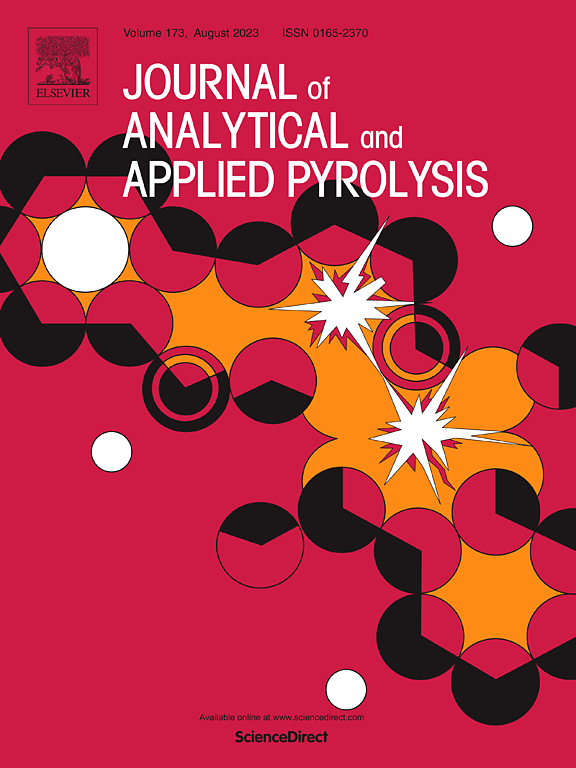Effects of differential hydrocarbon expulsion on the characteristics of saturated and aromatic compounds during hydrous pyrolysis of organic-rich shale
IF 5.8
2区 化学
Q1 CHEMISTRY, ANALYTICAL
引用次数: 0
Abstract
Primary migration and expulsion of hydrocarbons from organic-rich shales can remarkably alter the group compositions of shale oil, while the impacts on specific molecular constituents are still unclear. Here, a lacustrine Chang-7 organic-rich shale sample from the Ordos Basin was subjected to semi-closed and closed pyrolysis, and the characteristics and ratios of commonly used saturated and aromatic constituents of the collected oil and rock extracts were discussed. The results indicated that low-molecular-weight (<C20) normal alkanes and pristane (Pr) are preferentially expelled from the shale before oil-cracking stages. In contrast, high-molecular-weight normal alkanes and phytane (Ph) are retained within the shale due to the relatively more robust interactions with kerogen, and polarity dominantly affects the composition fractionation during the expulsion of aromatic compounds. This led to significant discrepancies in ratios of saturated and aromatic hydrocarbon compounds between the collected oil and rock extracts, such as (nC21+nC22)/(nC28+nC29), Pr/Ph, and indicators related to methylnaphthalene, methylphenanthrene, methyldibenzothiophene, and trifluorene series. Trends of those molecular ratios reverse due to intensive thermal cracking at higher maturities. The fractionation heavily affects the accuracy of maturity comparison of aromatic hydrocarbon ratios in shale source rocks and related hydrocarbon accumulations, ultimately casting doubts on oil-source correlations. Moreover, the fractionation can misguide inferences regarding paleoenvironmental conditions based on the trifluorene series and the ternary diagram of the Ph/nC18, Pr/Ph, and Pr/nC17. Finally, we propose that some proxies previously applied to maturity and paleoenvironmental evaluation can be used to indicate hydrocarbon expulsion.
富有机质页岩水合物热解过程中不同排烃方式对饱和烃和芳香烃特征的影响
富有机质页岩中烃类的初次运移和排出可以显著改变页岩油的组分组成,但对具体分子组分的影响尚不清楚。以鄂尔多斯盆地长7湖相富有机质页岩为研究对象,对其进行了半封闭和密闭热解,并对所采集的油岩提取物中常用饱和组分和芳香族组分的特征及比例进行了分析。结果表明,低分子量正构烷烃(<C20)和正构烷烃(Pr)在原油裂解前优先排出。相反,由于与干酪根的相互作用相对更强,高分子量正构烷烃和植烷(Ph)被保留在页岩中,极性主要影响芳香族化合物排出过程中的组分分馏。这导致所收集的石油和岩石提取物之间的饱和烃和芳烃化合物比率(nC21+nC22)/(nC28+nC29), Pr/Ph以及与甲基萘,甲基菲,甲基二苯并噻吩和三芴系列相关的指标存在显著差异。在较高的成熟度下,这些分子比的变化趋势由于强烈的热裂解而发生逆转。分馏严重影响了页岩烃源岩芳烃比值及相关油气成藏成熟度比较的准确性,最终使人们对油源对比产生怀疑。此外,分馏还会误导基于三芴系列和Ph/nC18、Pr/Ph、Pr/nC17三元图对古环境条件的推断。最后,提出了利用成熟度和古环境评价指标来指示排烃的方法。
本文章由计算机程序翻译,如有差异,请以英文原文为准。
求助全文
约1分钟内获得全文
求助全文
来源期刊
CiteScore
9.10
自引率
11.70%
发文量
340
审稿时长
44 days
期刊介绍:
The Journal of Analytical and Applied Pyrolysis (JAAP) is devoted to the publication of papers dealing with innovative applications of pyrolysis processes, the characterization of products related to pyrolysis reactions, and investigations of reaction mechanism. To be considered by JAAP, a manuscript should present significant progress in these topics. The novelty must be satisfactorily argued in the cover letter. A manuscript with a cover letter to the editor not addressing the novelty is likely to be rejected without review.

 求助内容:
求助内容: 应助结果提醒方式:
应助结果提醒方式:


